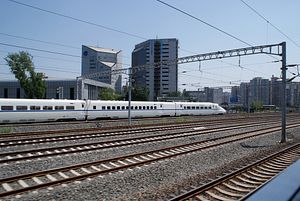The latest rail link between Beijing and London joins 38 lines already connecting about 30 cities in China and Europe. The expansion of rail links reflects several motivations on China’s part. First, China is actively promoting industrialization in China’s poorer inland provinces, both to balance development and to avoid rising costs in the coastal areas, thus keeping Chinese products competitive in the global market. In contrast to coastal locations, however, sea transport is more expensive and time-consuming for exporting goods produced in inland China. Thus, rail links across the Eurasian continent become a reasonable means of connecting with European markets. Those rail links also serve as part of the “One Belt, One Road (OBOR)” initiative to form economic corridors in Central Asia or even to East Europe.
Economic development in the Eurasian continent’s landlocked states in the continent has fallen behind, thanks to their lack of ocean access as well as the lingering impact of political barriers put up in the Soviet era. To accelerate their economic growth, railways would be the most efficient means to strengthen their trade with the rest of the world. Based on those states’ limited financial capacity, prices are a crucial factor in their ability to invest in rail transport, and the China Railway Rolling Stock Corp (CRRC) is seen as an affordable source, evidenced in the CRRC’s rapidly expanding business in East European and Central Asian states. In other words, the rail links also create demand for Chinese rail industry.
Although the OBOR initiative has a maritime component as well, China’s sea lines of communication (SLOCs) are vulnerable to external threats until the People’s Liberation Army Navy (PLAN) is able to provide sea control — a condition that may not be realized in the near future. In the meantime, railways provide an alternative route for trade. Despite the lower capacity and higher costs of rail lines in comparison with sea transport, several technological advances, such as more powerful locomotives, central traffic controls, and auto signalling systems, have improved the efficiency of rail transport. With increased, more efficient rail links to Europe, Beijing’s economic vulnerability to a naval blockade during wartime or a crisis would decrease.
However, several factors limit just how effective these railways can be in achieving Beijing’s goals. The dozens of existing rail links are not actually inter-connected at the moment. The rail systems in Kazakhstan, Russia, and Belarus use a wide gauge of 1.52 meters, a Soviet legacy, while the Chinese and European systems use a standard gauge of 1.435 m. That means that rail cargo has to be transferred between trains whenever crossing between the two regions of gauges, which occurs at least twice during the journey. Transferring cargo increases travel time and encourages the use of freight in standard containers, rather than bulky cargo such as crops.
Spain and a few countries have invented changeable bogies and wheels for trains running on different gauges, especially transferring between the standard and wide gauges. However, such expensive designs are mainly reserved for passenger trains and remain impractical for numerous freight trains. Technically, the rail lines in the former Soviet republics could be transformed into a dual gauge system but that would mean higher costs both in the initial modifications and in the ensuing maintenance. Beijing may not be willing to shoulder the expense. Furthermore, the wide gauge system was designed by the Soviets to deny a potential foreign invasion, which remains a significant strategic concern. Therefore the governments who use the wide gauge may not want to abandon this arrangement, as the standard gauge tracks connect not only to China but also to western Europe.
The gauge issue is not the only hurdle to Beijing’s strategy. Although the efficiency of rail systems is improving, the unavoidable need maintaining thousands of kilometers of tracks means rail will always be much more costly than sea transport, which only requires a few facilities along long routes. Unless transporting food or some time-sensitive merchandise, the faster speed of rail shipping may not matter much. As more and more developing countries join in the globalization of manufacturing, China’s inland provinces will face more serious competition than their coastal counterparts did in the 1990s and 2000s. Whether newly built Chinese industries in the inland provinces are competitive enough to absorb the additional costs of rail transport will be critical to determining their fate.
Rail shipping also may not necessarily be more reliable than sea transport in the event of a crisis. Unlike the high seas, rail lines are located in foreign sovereign terrains beyond Beijing’s jurisdiction, and the risk of disruption is also considerable. If any political turmoil occurs in a country along the rail routes (a not-improbable scenario in Central Asia), or even if a country simply sees souring relations with China, the rail links could be affected or cut. In the end, rail lines beyond China’s borders may not be more reliable than SLOCs.
Apart from politics, such transcontinental rail links are operated by different companies in various countries, which all have unique regulations, policies, and priorities. In other words, local rail operators may not have consensus on how to handle international trains. Domestic trains may be given higher priority over international ones in terms of deploying locomotives, using lines, or otherwise sharing local rail resources. Currently, Beijing can coordinate with those foreign operators for the small number of services invovled, but operational conflicts may appear with additional services, particularly if facilities and capacity are not simultaneously improved.
China’s rail links to European destinations are indeed unprecedented, and countries along the lines will benefit from better connectivity. China can then follow the trend, building up economic corridors like OBOR along the rail lines, and thereby secure wider influence in the region. However, these transcontinental rail links cannot totally compensate for China’s geographic handicaps, due to both technical constraints and sovereign control.
Wu Shang-su is a research fellow in the Military Studies Program of the S. Rajaratnam School of International Studies (RSIS), Nanyang Technological University.

































